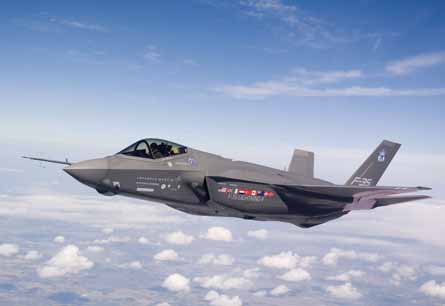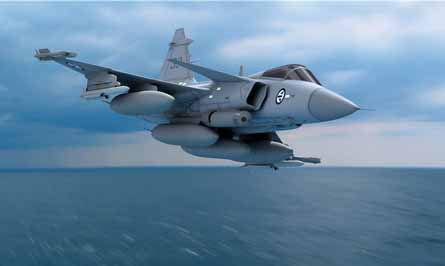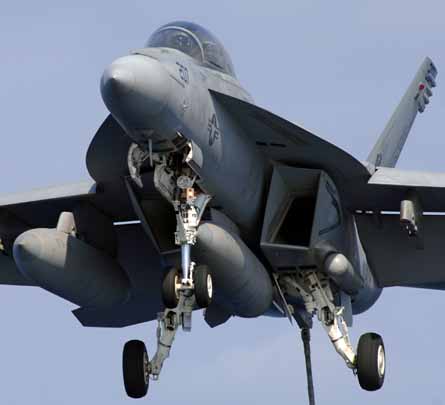The F-35 is on the shopping list of many nations that want to acquire stealthy combat aircraft
Norway is being offered a tailored version of the Gripen in its hard-fought contest with the Joint Strike Fighter (JSF) and Typhoon.
The F-35 is on the shopping list of many nations wanting stealthy combat aircraft |
The first half of 2007 has brought operational firsts for several Western fighter programmes, with the Dassault Rafale, Eurofighter Typhoon, Lockheed Martin F-22 Raptor and Saab Gripen making significant advances.
Norway is being offered a version of the Gripen |
Boeing has also secured its launch export order for the F/A-18E/F Super Hornet, while flight testing of Lockheed's first F-35 Joint Strike Fighter has gathered pace ahead of production deliveries from early next decade.
Such achievements are of great interest to the many nations looking to replace their ageing types with the best next-generation aircraft they can afford.
In operational parlance, the fighter arena is a "target-rich environment", with manufacturers running campaigns in numerous countries, hoping to secure lucrative re-equipment deals.
For the savvy buyer, the variety of aircraft on offer is enabling nations to drive a hard bargain while they seek best value and maximum industrial benefit.
A requirement to replace the Indian air force's Mikoyan MiG-21 fighters is the highest profile piece of business on today's export stage, with manufacturers already positioning themselves to secure the planned 126-aircraft deal.
To require the establishment of a local assembly line that industry sources believe could eventually deliver over 200 of the selected aircraft, the project has drawn interest with the Gripen, Rafale, Super Hornet, Typhoon, Lockheed F-16 and RSK's MiG-35.
But with a long-awaited request for proposals yet to be released, frustration is mounting among the potential bidders.
"Patience is the best thing to remember," says Boeing Integrated Defense Systems vice-president Asia-Pacific business development Mark Kronenberg, adding: "It's such a huge market that we can't ignore it."
Reflecting a hope held across industry, he says: "Once they make the RFP I think they'll move quickly to get it resolved."
The Indian air force is also receiving locally assembled Sukhoi Su-30 multirole fighters and will from late this decade field its first batch of 20 Aeronautical Development Agency-produced Tejas light combat aircraft after years of delay.
The Indian navy is meanwhile soon to receive its first MiG-29K carrier-borne fighters. Struggling to keep pace, neighbouring Pakistan is acquiring new F-16s and upgrading its current examples, while also introducing the Chengdu FC-1/JF-17 light fighter developed with China, and more F-7s from the same manufacturer.
Malaysia, meanwhile, joined the Su-30 owners club last month, accepting its first two of 18 examples from Russia.
Japan's requirement to replace its McDonnell Douglas F-4 Phantoms has again alerted the manufacturers of the Rafale, Super Hornet and Typhoon. Boeing, revitalised by recent orders from Singapore and South Korea, may also offer the F-15.
But Tokyo is pushing the US government to release its prized stealth technology, with the F-22 its first choice to lead the transformation effort.
Twelve US Air Force Raptors recently completed an almost three-month test of the service's ability to deploy and sustain the aircraft during a detachment at Japan's Kadena AB. Despite an initial software issue, the USAF says the deployment was successful.
Stealth debate
Although US Congress is debating the Japanese proposal, industry sources say a decision could take until the end of the decade, opening the door for an interim purchase of 20-30 less-expensive aircraft.
Tokyo is expected to issue its new fighter RFP late this year, with selection by early 2009. Deliveries could start in 2010.
Eager to keep pace with Japan, South Korea has also voiced interest in gaining approval to acquire the F-22 or F-35, although its immediate interest is in closing a deal by year-end for a further batch of 20 F-15Ks to join 40 ordered previously.
However, rivals such as the Typhoon are likely to emerge as Seoul prepares a fresh tender for around 60 more new fighters.
In another likely boost for Boeing, Singapore is deciding whether to acquire a further eight F-15SGs included as options in its 12-strong launch order for the type.
The company says this deal, along with the pending South Korean order and a possible 36-72 aircraft sale to Saudi Arabia, could safeguard production of the "Super Eagle" until at least 2015.
Saudi Arabia is also close to signing a production contract with the UK government for 72 Typhoons, and BAE Systems is now seeking to recruit engineering and logistics advisers and training supervisors to establish activities in the kingdom.
Riyadh's first 24 Typhoons are expected to come off the UK company's final assembly line in Warton, Lancashire, with the remainder to be completed in-country.
Typhoons from Spain and the UK recently underwent their first bilateral exercise, and the Royal Air Force will from next month provide quick reaction alert cover for the southern UK with the type, and could deploy it to Afghanistan next year.
The four-nation Eurofighter programme was also early this year boosted by the signature of a Tranche 2 capability enhancement package worth €1.2 billion ($1.6 billion) that will deliver improvements in areas such as air-to-surface weapons and computing.
A Eurofighter has also flown for the first time with the Euroradar Caesar active electronically scanned array radar - a key part of future Typhoon enhancements and Tranche 3 production plans.
Production of 18 Eurofighters for launch export buyer Austria continues apace, despite a continuing legal process mounted by Vienna's recently elected government that aims to overturn the deal signed by the previous administration a threat unlikely to be enacted due to contractual terms.
The Typhoon is also in the contest for a long-held requirement in Greece for around 40 aircraft, battling the F-16, Gripen, Rafale and Super Hornet. Eurofighter also hopes to sell the Typhoon to JSF partner Turkey, which last month signed an attrition deal for 30 F-16 Block 52+ fighters.
A major export deal already signed this year will see Australia field 24 F/A-18F Super Hornet Block II fighters as interim replacements for its 26 General Dynamics F-111s. Deliveries of the two-seat aircraft will run from 2010-11, and the total deal - including weapons and support costs - is estimated at A$6 billion ($4.9 billion).
Boeing targets
Canberra currently plans to move to an all JSF force, and will in the next decade decide its long-term plans for the F/A-18F. Its Super Hornet acquisition represents the first export for the Boeing product, and the company hopes to build on its success by landing orders to also supply existing Hornet users, including Kuwait.
Boeing hopes for more Super Hornet users |
Bulgaria is eyed as a potential buyer, although the Gripen is also in Sofia's contest for around 20 aircraft, launched last year.
Boeing expects export business and additional US Navy contracts to keep its Super Hornet production line active until mid-way through the next decade. Overseas buyers could also acquire the aircraft with Raytheon's APG-79 AESA radar, which is to equip new USN aircraft from its Lot 30 production examples.
Many nations are looking at the F-35 as a potential solution for their future combat aircraft needs, although delays to the project have extended the window of opportunity available to Lockheed's rivals.
Norway provides perhaps the clearest example of a nation keeping its options fully open, with agreements signed for involvement in the JSF, Gripen and Typhoon projects.
Oslo is demanding worthwhile involvement for its defence industry, which offers expertise in areas such as air-to-surface weapons, targeting systems, composite materials and communications equipment.
Team JSF faces a challenge in keeping all eight of Washington's current partners happy, but lists Israel, still receiving advanced F-16Is and also seeking information on the larger F-22, plus Japan and Spain as potential near-term buyers.
France's Rafale is currently tasting its first combat use at the hands of the nation's air force, which is supporting NATO operations in Afghanistan from Tajikistan with three F2-standard aircraft, alongside three French navy examples.
Dassault continues to eye Brazil as a future operator once its delayed F-X contest is revived, potentially from later this year. As an interim measure, the Brazilian air force last year received its first ex-French air force Dassault Mirage 2000-5s.
The Rafale's long-term sales prospects will be supported by continued investment, such as in an AESA enhancement for its Thales RBE2 radar funded last October.
A trial fit of an active phased array with the Rafale is scheduled to take place this quarter, with Thales expecting the sensor to achieve operational status by 2012.
Gripen prospects
Saab-led Gripen International, meanwhile, hopes to build on its current export deals with the Czech Republic, Hungary - which last month participated in its first overseas exercise with the aircraft - and South Africa over the coming years, with range and payload increases and an AESA front end for its Saab Microwave Systems PS05 radar under study.
In addition to its current production of MiG and Sukhoi fighters for the domestic and export markets, Russia is pursuing the development of a national counterpart to designs such as Lockheed's F-35.
Moscow's next-generation PAK FA project is claimed to be on track to achieve the first flight of a prototype aircraft in late 2008, with a production-representative airframe with newly designed engines to follow in 2012.
However, state funding issues are affecting the Sukhoi-led project to the frustration of national industry, which is being called upon to self-fund much of the work.
China's efforts to develop a credible fourth-generation fighter meanwhile appear to be bearing fruit, with Chengdu's single-engined J-10 entering frontline use in increasing numbers.
Chinese companies are expected to become more significant players on the export market over the next 15 years, and it appears that in the fighter arena the nation is also rapidly closing the technology gap with many more developed nations.
This knowledge alone should ensure that Western governments continue to invest significant sums in developing the capabilities of their fighter aircraft fleets, guard, both their operational and industrial interests.
ADDITIONAL REPORTING BY HELEN MASSY-BERESFORD IN ST LOUIS
Source: Flight International


























